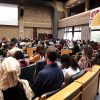Tuesday, May 14, 2024
News and Views from the Global South
Opinion
Lessons From a Unique Decade
- The fight against poverty and hunger cannot waste time, nor disdain any scales of action. Public and private initiatives are critical and must include both family farming and so-called agribusiness. It is up to governments and international cooperation to harmonise this collective economic effort and to ensure that bigger harvests translate into increased food security for the needy.
The futures of real people are at stake. How a society responds to this challenge will define what happens to people on the outside of society. This response also helps shape patterns of development and influences relations between markets, states and democracies.
Our decisions must be guided neither by theory nor by ideology. The best advice to hear when making these choices is the voice of experience.
Latin America, for example, has been an advanced test plot for coexistence between large-scale and small-scale farmers. Ten years of social protection and agricultural production policies implemented in a context of economic expansion provide a unique gamut of regional experiences.
To what extent has this combination generated the conditions necessary to break down cycles that perpetuate poverty? Both the question and its answer are important for the agenda of the global fight against hunger and extreme poverty.
In the 1980s, the end of a cycle of international financial liquidity laid bare the fragility of Latin America’s growth model. The 1990s’ allegiance to canons of
self-sufficient markets subjected the region’s economies to one financial collapse after another and debunked the existence of self-regulating counterbalances promised by laissez-faire.
The social cost was devastating. Thirty one million Latin Americans became extremely poor in the 1990s.
Once that damage had been quantified, space was opened for rectifying policies, which were progressively incorporated into the region’s development agenda.
A single figure reveals the scale of this new approach: one out of every five Latin American and Caribbean citizens – nearly 113 million people – now participate in conditional income transfer programs.
This action has tempered the impact of the world crisis that began in 2007. The region’s gross domestic product (GDP) fell by three percent in 2009. In contrast to previous crises, however, progress made did not all turn to dust. After 41 million people in the region had stepped out of poverty since 2002 and another 26 million had broken their chains of extreme poverty, nine million fell back to where they were before.
Structural weaknesses do indeed persist, favouring relapses back to poverty and hunger, particularly in rural areas, where exclusion is most present.
Today, 13 percent of the region’s population is extremely poor: 35 million live in the countryside; 35 million live in the cities.
That apparent symmetry is misleading; 30 percent of those who live in rural areas are extremely poor, four times more – proportionally – than those in urban areas (eight percent), according to the Economic Commission for Latin America and the Caribbean (ECLAC).
The data leaves no room for delusions about spontaneous and automatic economic processes that set social inequities right.
From 1980 to 2010, and particularly over this past decade, the region’s agricultural exports have set one price and volume record after another, propelled by global demand for commodities.
Over the same period, nonetheless, the retreat of rural poverty has been negligible in Latin America and the Caribbean: from 60 percent in 1980, down to 53 percent in 2010, as we learn from a joint study by ECLAC, FAO and the International Labour Organisation, entitled ‘Agricultural Boom and the Persistence of Rural Poverty in Latin America and the Caribbean’.
The fact that the greatest proportion of the region’s extremely poor lives in rural areas forces us to face two parallel but undeniable realities.
The first is that abundant harvests are no guarantee of food security, even for the people who live there. Second, big business is here to stay in agriculture and plays a strategic role in generating foreign reserves for developing countries and in supplying world markets.
In Latin America and the Caribbean, we have learned once again that supply is not synonymous with access. Hunger can coexist perversely with plenty.
This paradox underlines the importance of consolidating a third dimension to harmonise the whole, namely the responsibility of public policies to consolidate workers’ rights in the countryside, eradicate precarious labour, respect tenure on small farms, make and foster investments for the food security of vulnerable people, topple gender barriers, support family farming, multiply small-scale farmer cooperatives and boost yields to generate surpluses, income and adequate supply for domestic markets.
The concentration of poverty and hunger in rural areas does not happen only in Latin America and the Caribbean, which is why the lessons of this experience apply far beyond the region. Worldwide, 900 million people are hungry and at least 70 percent of them live in rural areas.
The vulnerability of people whose livelihoods depend on the land is also greater. A third of the people in the world live on small farms less than 10 hectares in size, only two percent of which are technified and 70 percent of which depend exclusively on their own muscle-power for production. In the 21st century, 40 percent of humanity still depends on agriculture, the world’s biggest employer.
Latin America’s anti-hunger and anti-poverty agenda therefore echoes transcontinental deficiencies. The same can be said of the need for public policies to expand labour rights, investments and citizenship in rural areas. (END/COPYRIGHT IPS)
* Jose Graziano da Silva is the director-general of the United Nations Food and Agriculture Organization (FAO).

 Print
Print



